Business Analysis and Planning: Data Collection and Analysis Report
VerifiedAdded on 2020/07/22
|26
|3664
|59
Report
AI Summary
This report provides a detailed analysis of data collection strategies, focusing on both primary and secondary sources, including surveys, interviews, and reviews of books, journals, and websites. The report explores various data analysis techniques such as observation, focus groups, contact interviews, thematic analysis, and regression analysis using SPSS. The thematic analysis involves frequency tables to identify response patterns, while regression analysis is used to determine the relationship between dependent and independent variables. The report includes a case study on residential care homes, examining factors like service quality, family environment, and earning opportunities. The findings are presented through frequency distributions and statistical analyses, with interpretations of the results. The study concludes by assessing the impact of service quality on earning opportunities within the context of luxury residential care homes, highlighting the relationships between variables and the significance of the findings.
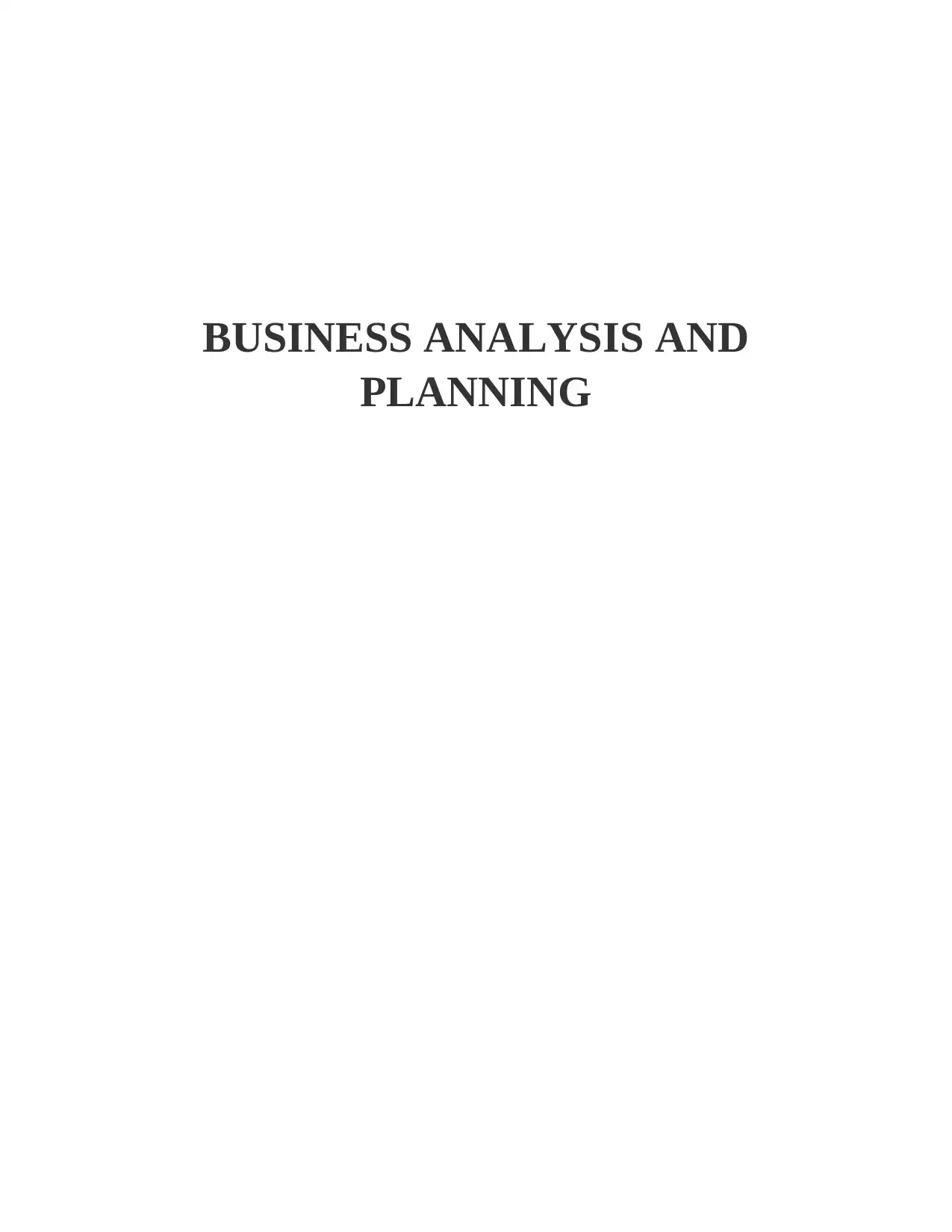
BUSINESS ANALYSIS AND
PLANNING
PLANNING
Paraphrase This Document
Need a fresh take? Get an instant paraphrase of this document with our AI Paraphraser
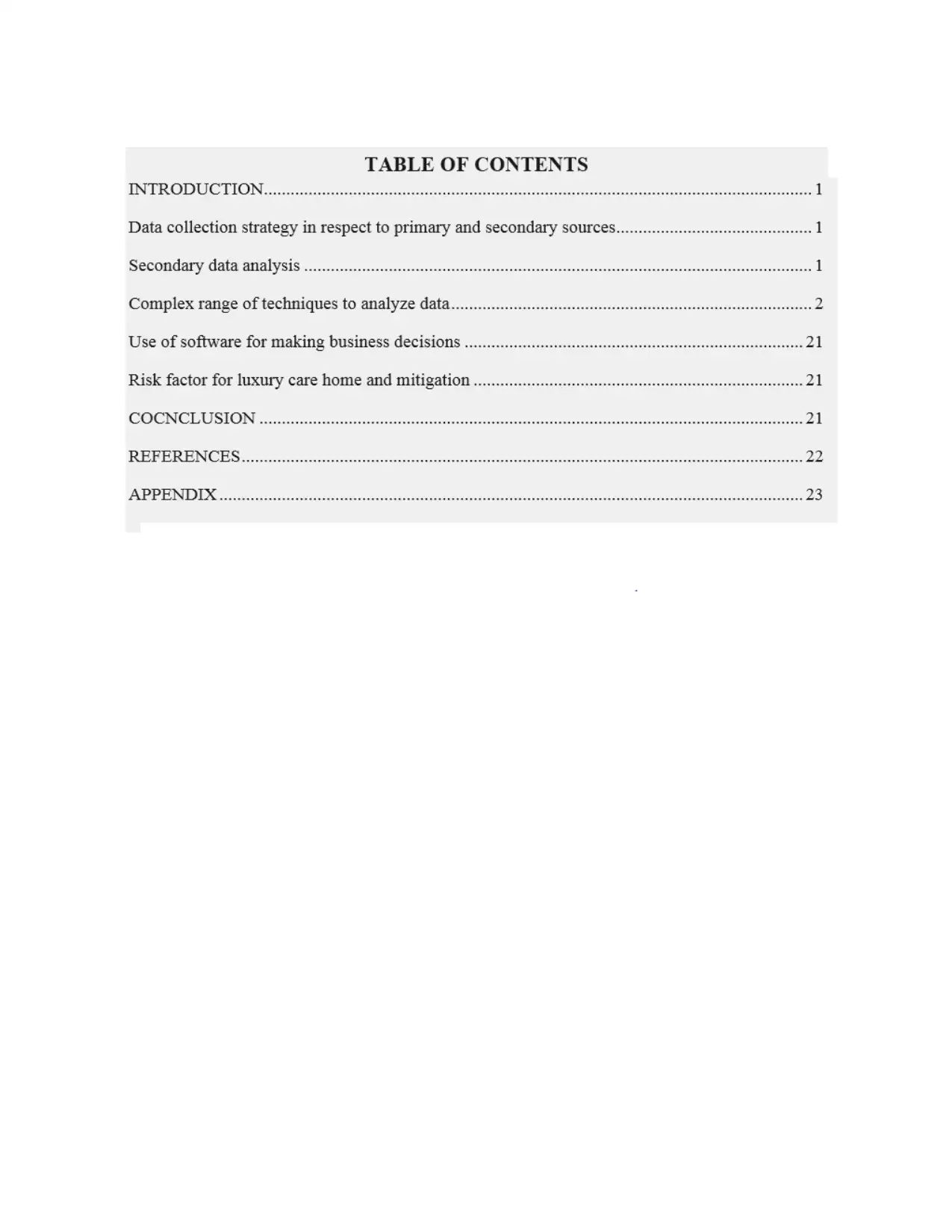
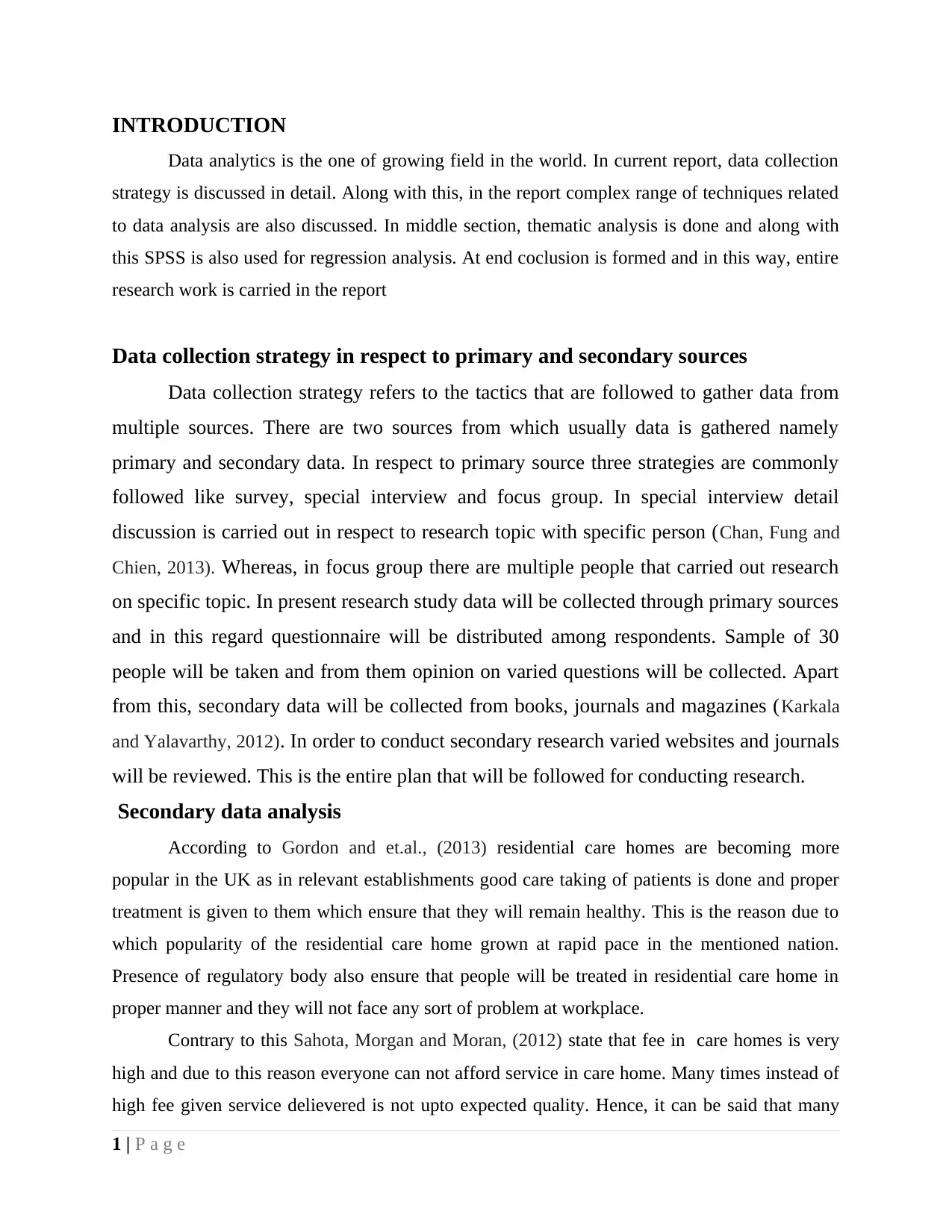
INTRODUCTION
Data analytics is the one of growing field in the world. In current report, data collection
strategy is discussed in detail. Along with this, in the report complex range of techniques related
to data analysis are also discussed. In middle section, thematic analysis is done and along with
this SPSS is also used for regression analysis. At end coclusion is formed and in this way, entire
research work is carried in the report
Data collection strategy in respect to primary and secondary sources
Data collection strategy refers to the tactics that are followed to gather data from
multiple sources. There are two sources from which usually data is gathered namely
primary and secondary data. In respect to primary source three strategies are commonly
followed like survey, special interview and focus group. In special interview detail
discussion is carried out in respect to research topic with specific person (Chan, Fung and
Chien, 2013). Whereas, in focus group there are multiple people that carried out research
on specific topic. In present research study data will be collected through primary sources
and in this regard questionnaire will be distributed among respondents. Sample of 30
people will be taken and from them opinion on varied questions will be collected. Apart
from this, secondary data will be collected from books, journals and magazines (Karkala
and Yalavarthy, 2012). In order to conduct secondary research varied websites and journals
will be reviewed. This is the entire plan that will be followed for conducting research.
Secondary data analysis
According to Gordon and et.al., (2013) residential care homes are becoming more
popular in the UK as in relevant establishments good care taking of patients is done and proper
treatment is given to them which ensure that they will remain healthy. This is the reason due to
which popularity of the residential care home grown at rapid pace in the mentioned nation.
Presence of regulatory body also ensure that people will be treated in residential care home in
proper manner and they will not face any sort of problem at workplace.
Contrary to this Sahota, Morgan and Moran, (2012) state that fee in care homes is very
high and due to this reason everyone can not afford service in care home. Many times instead of
high fee given service delievered is not upto expected quality. Hence, it can be said that many
1 | P a g e
Data analytics is the one of growing field in the world. In current report, data collection
strategy is discussed in detail. Along with this, in the report complex range of techniques related
to data analysis are also discussed. In middle section, thematic analysis is done and along with
this SPSS is also used for regression analysis. At end coclusion is formed and in this way, entire
research work is carried in the report
Data collection strategy in respect to primary and secondary sources
Data collection strategy refers to the tactics that are followed to gather data from
multiple sources. There are two sources from which usually data is gathered namely
primary and secondary data. In respect to primary source three strategies are commonly
followed like survey, special interview and focus group. In special interview detail
discussion is carried out in respect to research topic with specific person (Chan, Fung and
Chien, 2013). Whereas, in focus group there are multiple people that carried out research
on specific topic. In present research study data will be collected through primary sources
and in this regard questionnaire will be distributed among respondents. Sample of 30
people will be taken and from them opinion on varied questions will be collected. Apart
from this, secondary data will be collected from books, journals and magazines (Karkala
and Yalavarthy, 2012). In order to conduct secondary research varied websites and journals
will be reviewed. This is the entire plan that will be followed for conducting research.
Secondary data analysis
According to Gordon and et.al., (2013) residential care homes are becoming more
popular in the UK as in relevant establishments good care taking of patients is done and proper
treatment is given to them which ensure that they will remain healthy. This is the reason due to
which popularity of the residential care home grown at rapid pace in the mentioned nation.
Presence of regulatory body also ensure that people will be treated in residential care home in
proper manner and they will not face any sort of problem at workplace.
Contrary to this Sahota, Morgan and Moran, (2012) state that fee in care homes is very
high and due to this reason everyone can not afford service in care home. Many times instead of
high fee given service delievered is not upto expected quality. Hence, it can be said that many
1 | P a g e
⊘ This is a preview!⊘
Do you want full access?
Subscribe today to unlock all pages.

Trusted by 1+ million students worldwide
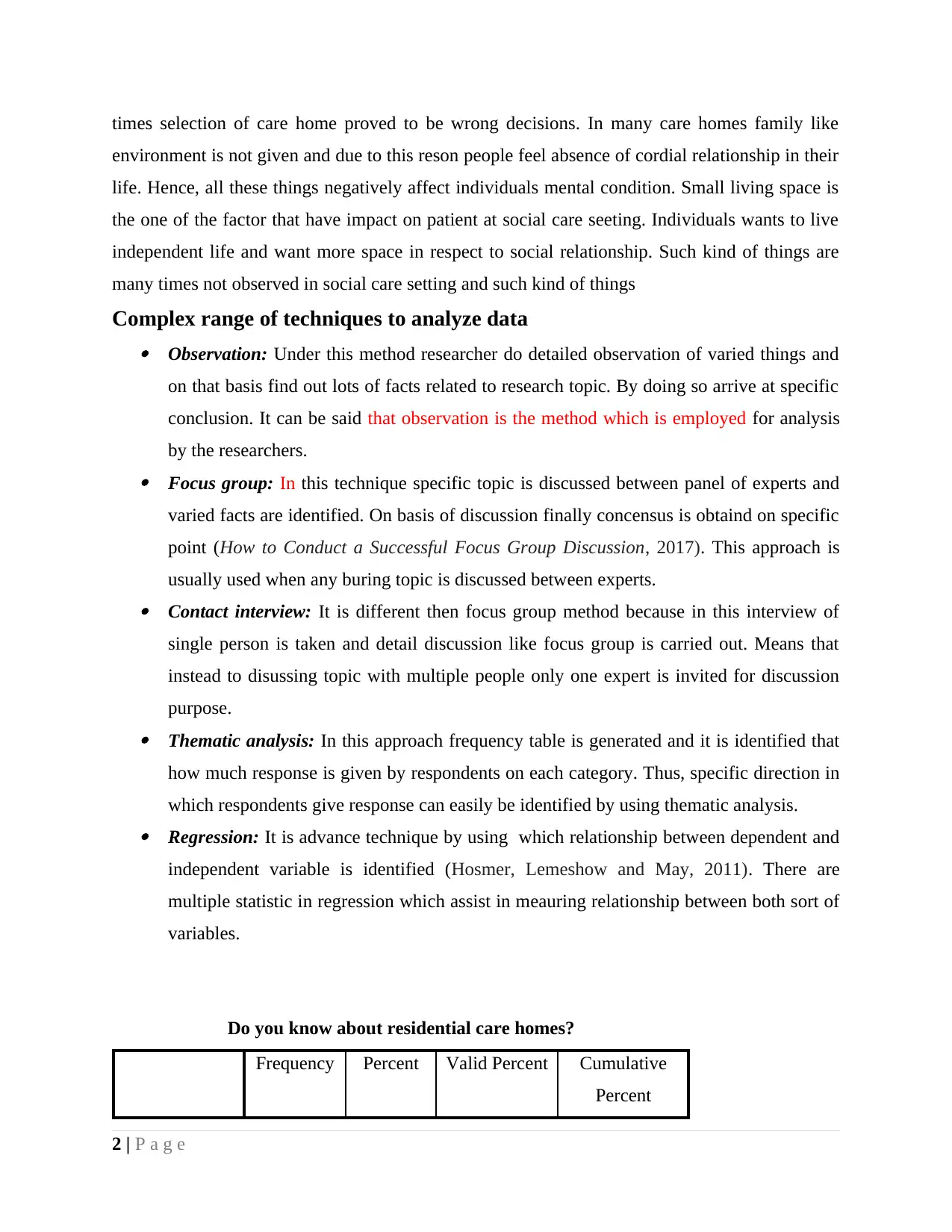
times selection of care home proved to be wrong decisions. In many care homes family like
environment is not given and due to this reson people feel absence of cordial relationship in their
life. Hence, all these things negatively affect individuals mental condition. Small living space is
the one of the factor that have impact on patient at social care seeting. Individuals wants to live
independent life and want more space in respect to social relationship. Such kind of things are
many times not observed in social care setting and such kind of things
Complex range of techniques to analyze data Observation: Under this method researcher do detailed observation of varied things and
on that basis find out lots of facts related to research topic. By doing so arrive at specific
conclusion. It can be said that observation is the method which is employed for analysis
by the researchers. Focus group: In this technique specific topic is discussed between panel of experts and
varied facts are identified. On basis of discussion finally concensus is obtaind on specific
point (How to Conduct a Successful Focus Group Discussion, 2017). This approach is
usually used when any buring topic is discussed between experts. Contact interview: It is different then focus group method because in this interview of
single person is taken and detail discussion like focus group is carried out. Means that
instead to disussing topic with multiple people only one expert is invited for discussion
purpose. Thematic analysis: In this approach frequency table is generated and it is identified that
how much response is given by respondents on each category. Thus, specific direction in
which respondents give response can easily be identified by using thematic analysis. Regression: It is advance technique by using which relationship between dependent and
independent variable is identified (Hosmer, Lemeshow and May, 2011). There are
multiple statistic in regression which assist in meauring relationship between both sort of
variables.
Do you know about residential care homes?
Frequency Percent Valid Percent Cumulative
Percent
2 | P a g e
environment is not given and due to this reson people feel absence of cordial relationship in their
life. Hence, all these things negatively affect individuals mental condition. Small living space is
the one of the factor that have impact on patient at social care seeting. Individuals wants to live
independent life and want more space in respect to social relationship. Such kind of things are
many times not observed in social care setting and such kind of things
Complex range of techniques to analyze data Observation: Under this method researcher do detailed observation of varied things and
on that basis find out lots of facts related to research topic. By doing so arrive at specific
conclusion. It can be said that observation is the method which is employed for analysis
by the researchers. Focus group: In this technique specific topic is discussed between panel of experts and
varied facts are identified. On basis of discussion finally concensus is obtaind on specific
point (How to Conduct a Successful Focus Group Discussion, 2017). This approach is
usually used when any buring topic is discussed between experts. Contact interview: It is different then focus group method because in this interview of
single person is taken and detail discussion like focus group is carried out. Means that
instead to disussing topic with multiple people only one expert is invited for discussion
purpose. Thematic analysis: In this approach frequency table is generated and it is identified that
how much response is given by respondents on each category. Thus, specific direction in
which respondents give response can easily be identified by using thematic analysis. Regression: It is advance technique by using which relationship between dependent and
independent variable is identified (Hosmer, Lemeshow and May, 2011). There are
multiple statistic in regression which assist in meauring relationship between both sort of
variables.
Do you know about residential care homes?
Frequency Percent Valid Percent Cumulative
Percent
2 | P a g e
Paraphrase This Document
Need a fresh take? Get an instant paraphrase of this document with our AI Paraphraser
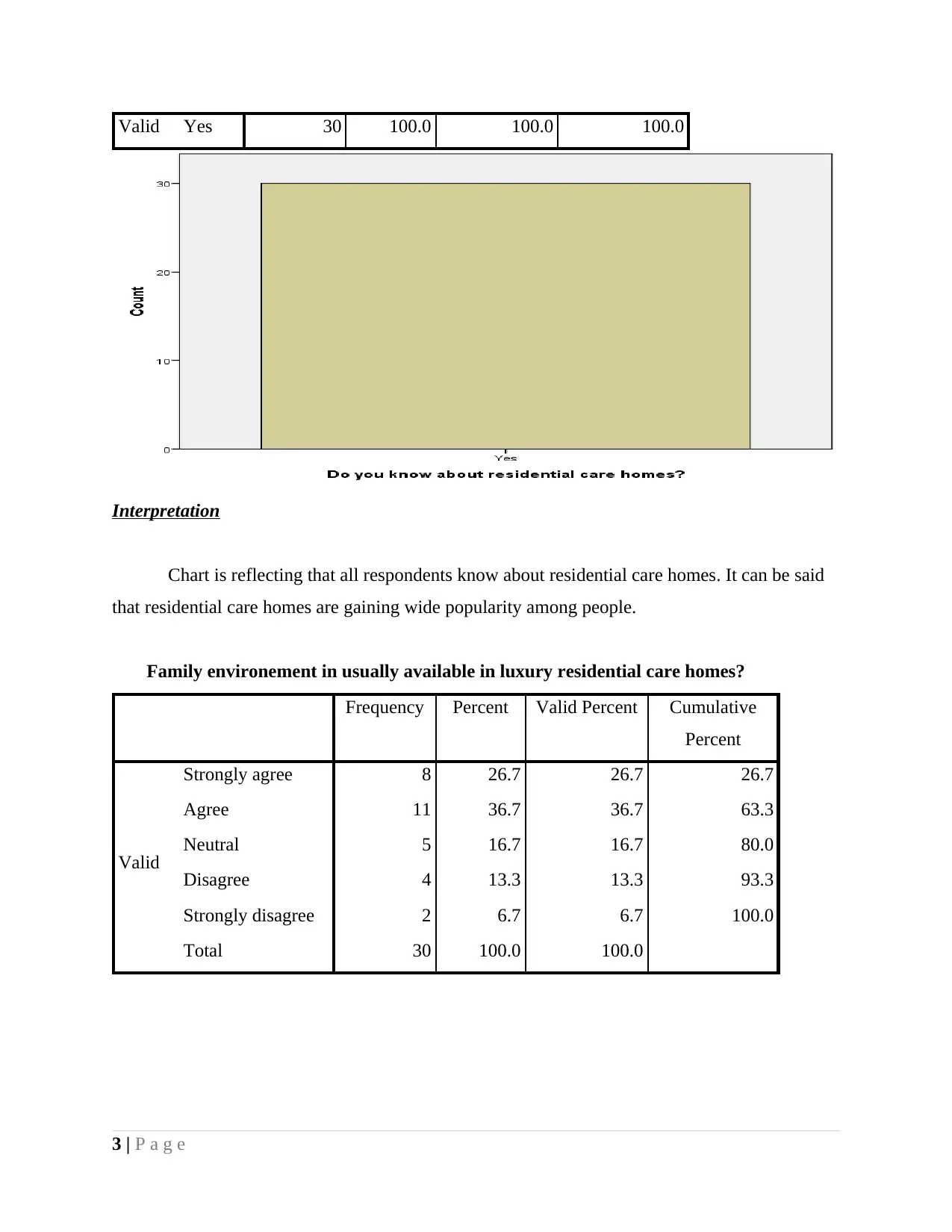
Valid Yes 30 100.0 100.0 100.0
Interpretation
Chart is reflecting that all respondents know about residential care homes. It can be said
that residential care homes are gaining wide popularity among people.
Family environement in usually available in luxury residential care homes?
Frequency Percent Valid Percent Cumulative
Percent
Valid
Strongly agree 8 26.7 26.7 26.7
Agree 11 36.7 36.7 63.3
Neutral 5 16.7 16.7 80.0
Disagree 4 13.3 13.3 93.3
Strongly disagree 2 6.7 6.7 100.0
Total 30 100.0 100.0
3 | P a g e
Interpretation
Chart is reflecting that all respondents know about residential care homes. It can be said
that residential care homes are gaining wide popularity among people.
Family environement in usually available in luxury residential care homes?
Frequency Percent Valid Percent Cumulative
Percent
Valid
Strongly agree 8 26.7 26.7 26.7
Agree 11 36.7 36.7 63.3
Neutral 5 16.7 16.7 80.0
Disagree 4 13.3 13.3 93.3
Strongly disagree 2 6.7 6.7 100.0
Total 30 100.0 100.0
3 | P a g e
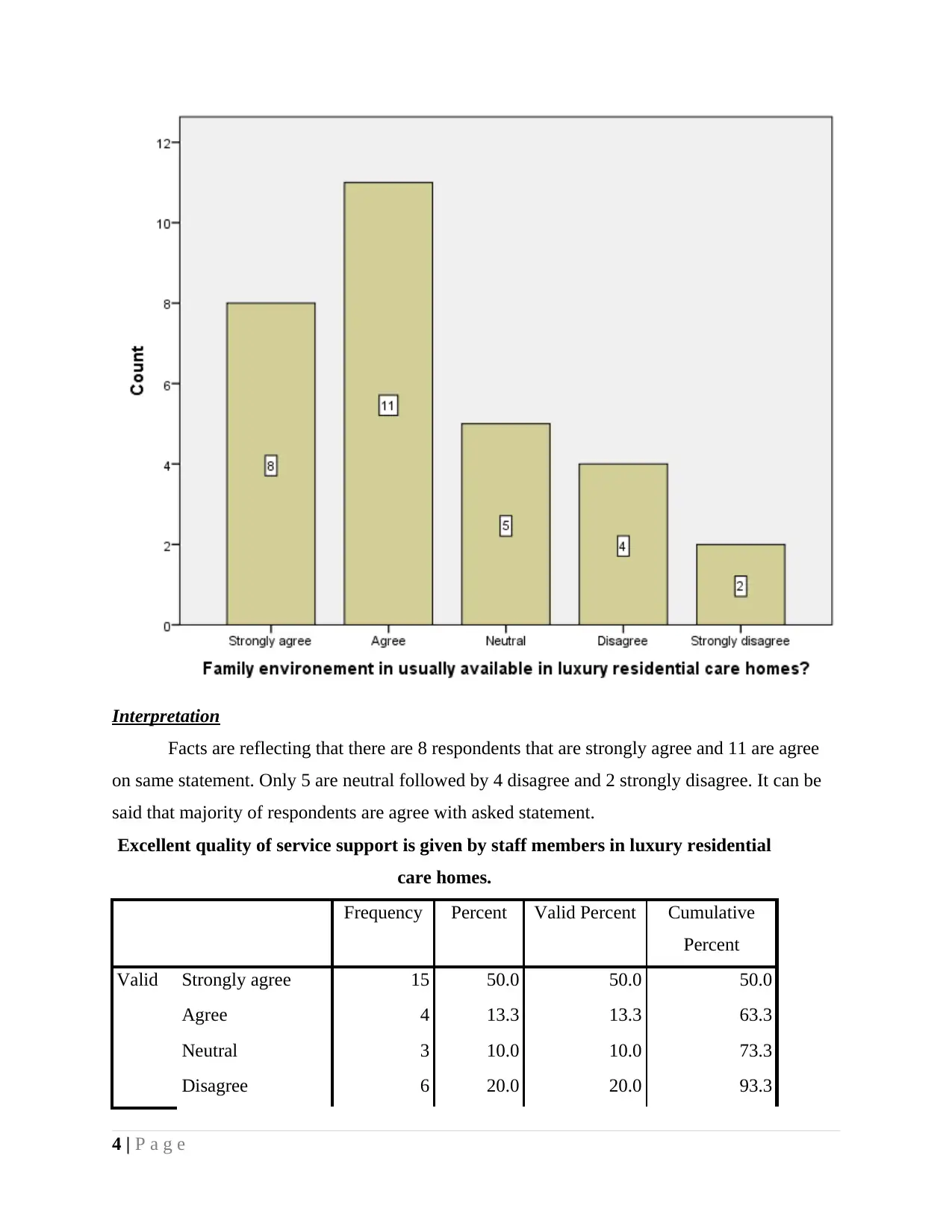
Interpretation
Facts are reflecting that there are 8 respondents that are strongly agree and 11 are agree
on same statement. Only 5 are neutral followed by 4 disagree and 2 strongly disagree. It can be
said that majority of respondents are agree with asked statement.
Excellent quality of service support is given by staff members in luxury residential
care homes.
Frequency Percent Valid Percent Cumulative
Percent
Valid Strongly agree 15 50.0 50.0 50.0
Agree 4 13.3 13.3 63.3
Neutral 3 10.0 10.0 73.3
Disagree 6 20.0 20.0 93.3
4 | P a g e
Facts are reflecting that there are 8 respondents that are strongly agree and 11 are agree
on same statement. Only 5 are neutral followed by 4 disagree and 2 strongly disagree. It can be
said that majority of respondents are agree with asked statement.
Excellent quality of service support is given by staff members in luxury residential
care homes.
Frequency Percent Valid Percent Cumulative
Percent
Valid Strongly agree 15 50.0 50.0 50.0
Agree 4 13.3 13.3 63.3
Neutral 3 10.0 10.0 73.3
Disagree 6 20.0 20.0 93.3
4 | P a g e
⊘ This is a preview!⊘
Do you want full access?
Subscribe today to unlock all pages.

Trusted by 1+ million students worldwide
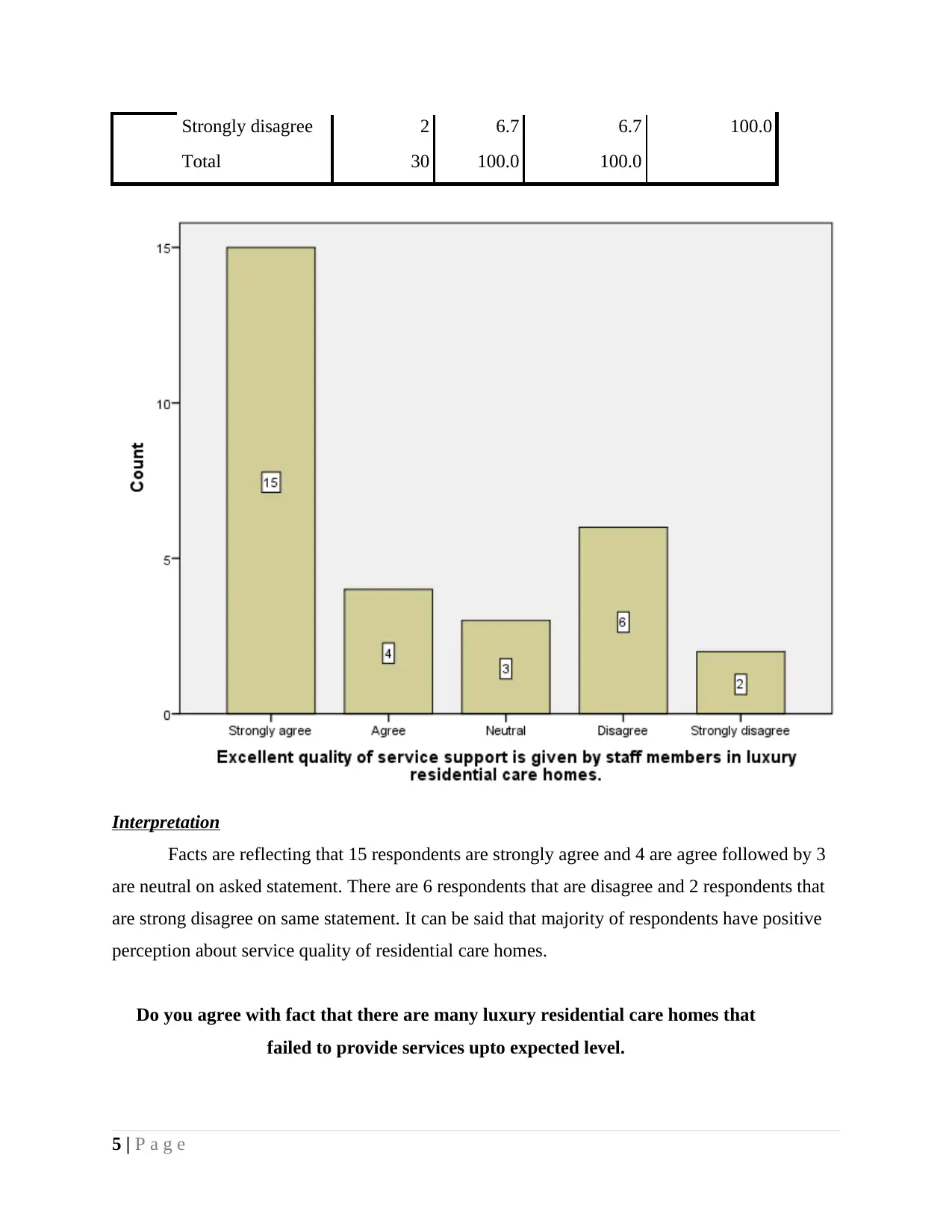
Strongly disagree 2 6.7 6.7 100.0
Total 30 100.0 100.0
Interpretation
Facts are reflecting that 15 respondents are strongly agree and 4 are agree followed by 3
are neutral on asked statement. There are 6 respondents that are disagree and 2 respondents that
are strong disagree on same statement. It can be said that majority of respondents have positive
perception about service quality of residential care homes.
Do you agree with fact that there are many luxury residential care homes that
failed to provide services upto expected level.
5 | P a g e
Total 30 100.0 100.0
Interpretation
Facts are reflecting that 15 respondents are strongly agree and 4 are agree followed by 3
are neutral on asked statement. There are 6 respondents that are disagree and 2 respondents that
are strong disagree on same statement. It can be said that majority of respondents have positive
perception about service quality of residential care homes.
Do you agree with fact that there are many luxury residential care homes that
failed to provide services upto expected level.
5 | P a g e
Paraphrase This Document
Need a fresh take? Get an instant paraphrase of this document with our AI Paraphraser
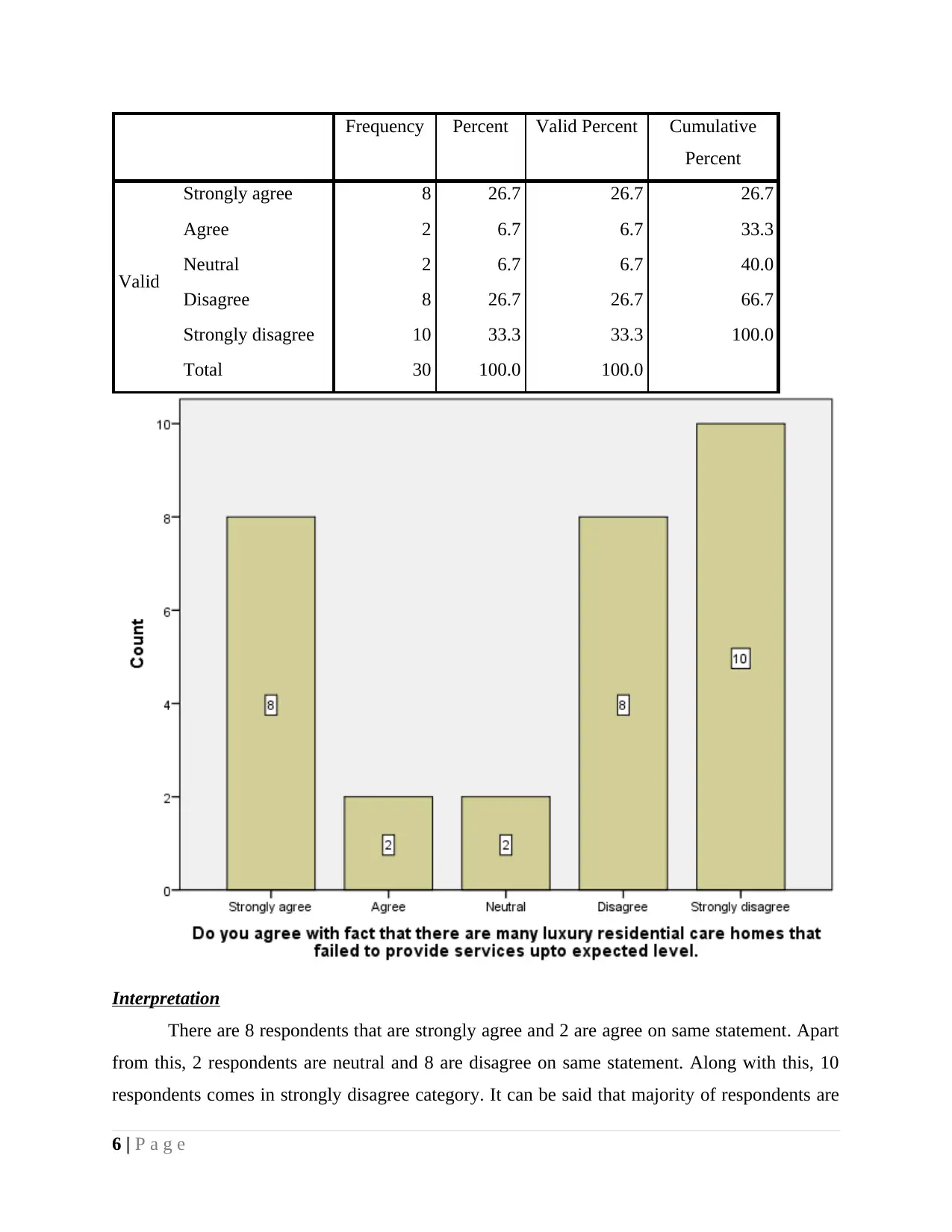
Frequency Percent Valid Percent Cumulative
Percent
Valid
Strongly agree 8 26.7 26.7 26.7
Agree 2 6.7 6.7 33.3
Neutral 2 6.7 6.7 40.0
Disagree 8 26.7 26.7 66.7
Strongly disagree 10 33.3 33.3 100.0
Total 30 100.0 100.0
Interpretation
There are 8 respondents that are strongly agree and 2 are agree on same statement. Apart
from this, 2 respondents are neutral and 8 are disagree on same statement. Along with this, 10
respondents comes in strongly disagree category. It can be said that majority of respondents are
6 | P a g e
Percent
Valid
Strongly agree 8 26.7 26.7 26.7
Agree 2 6.7 6.7 33.3
Neutral 2 6.7 6.7 40.0
Disagree 8 26.7 26.7 66.7
Strongly disagree 10 33.3 33.3 100.0
Total 30 100.0 100.0
Interpretation
There are 8 respondents that are strongly agree and 2 are agree on same statement. Apart
from this, 2 respondents are neutral and 8 are disagree on same statement. Along with this, 10
respondents comes in strongly disagree category. It can be said that majority of respondents are
6 | P a g e
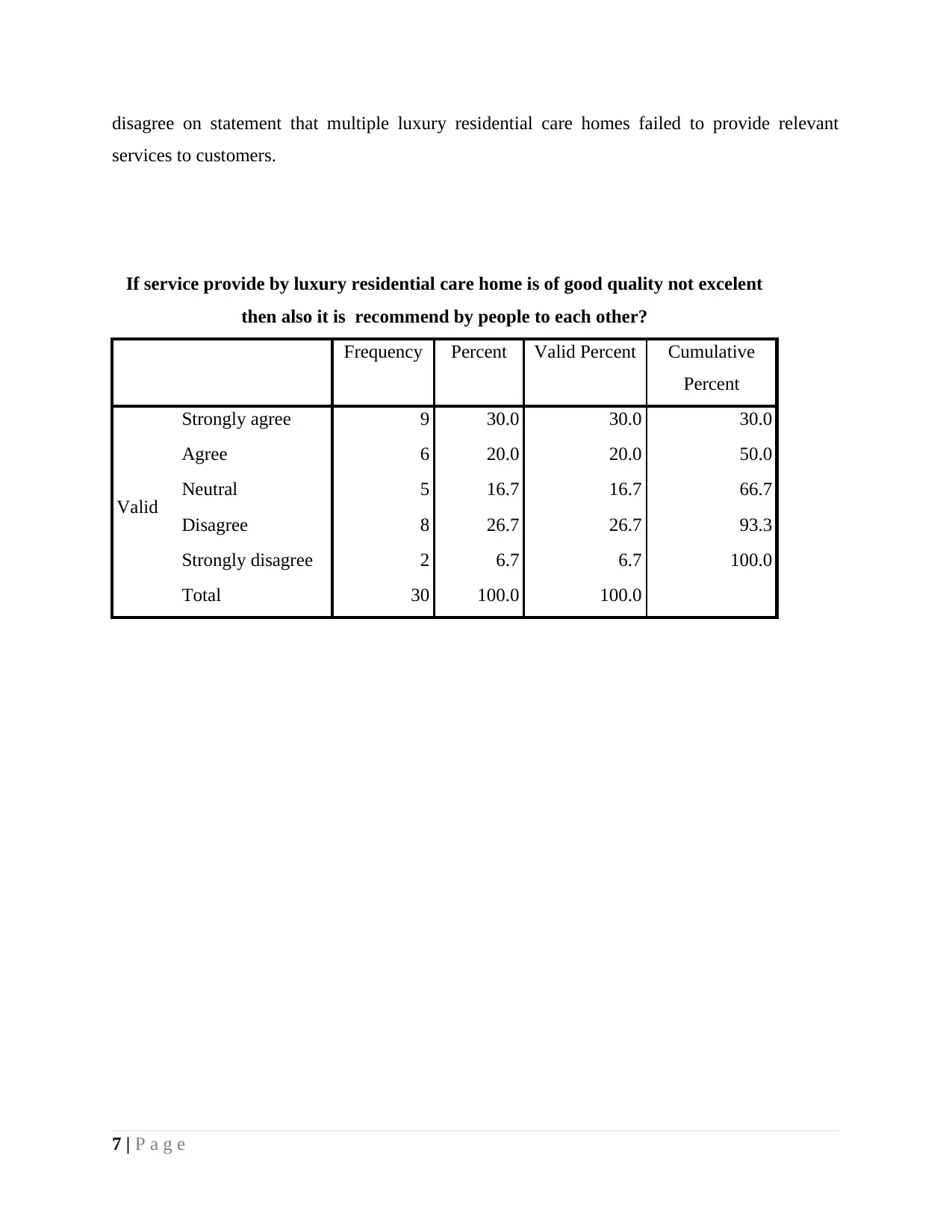
disagree on statement that multiple luxury residential care homes failed to provide relevant
services to customers.
If service provide by luxury residential care home is of good quality not excelent
then also it is recommend by people to each other?
Frequency Percent Valid Percent Cumulative
Percent
Valid
Strongly agree 9 30.0 30.0 30.0
Agree 6 20.0 20.0 50.0
Neutral 5 16.7 16.7 66.7
Disagree 8 26.7 26.7 93.3
Strongly disagree 2 6.7 6.7 100.0
Total 30 100.0 100.0
7 | P a g e
services to customers.
If service provide by luxury residential care home is of good quality not excelent
then also it is recommend by people to each other?
Frequency Percent Valid Percent Cumulative
Percent
Valid
Strongly agree 9 30.0 30.0 30.0
Agree 6 20.0 20.0 50.0
Neutral 5 16.7 16.7 66.7
Disagree 8 26.7 26.7 93.3
Strongly disagree 2 6.7 6.7 100.0
Total 30 100.0 100.0
7 | P a g e
⊘ This is a preview!⊘
Do you want full access?
Subscribe today to unlock all pages.

Trusted by 1+ million students worldwide
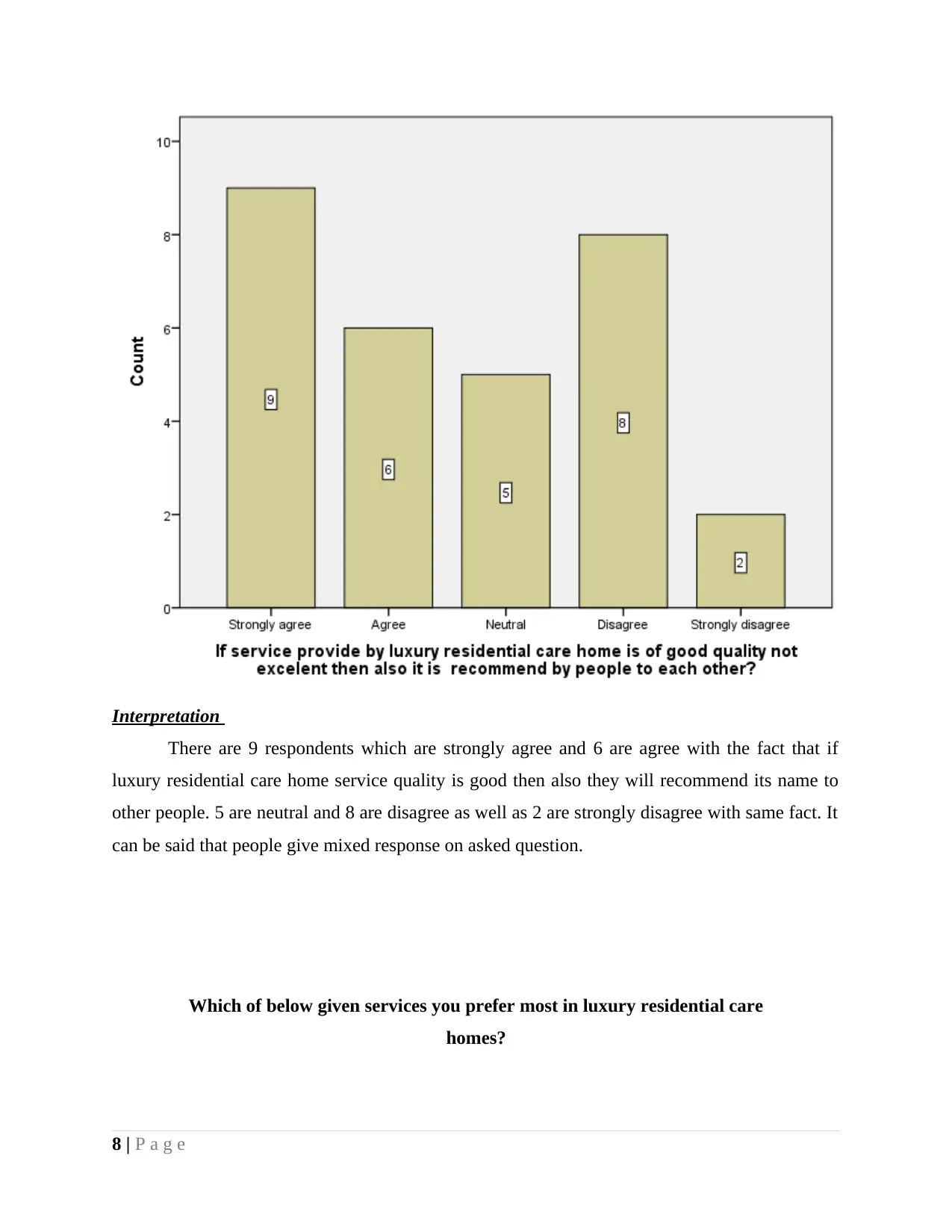
Interpretation
There are 9 respondents which are strongly agree and 6 are agree with the fact that if
luxury residential care home service quality is good then also they will recommend its name to
other people. 5 are neutral and 8 are disagree as well as 2 are strongly disagree with same fact. It
can be said that people give mixed response on asked question.
Which of below given services you prefer most in luxury residential care
homes?
8 | P a g e
There are 9 respondents which are strongly agree and 6 are agree with the fact that if
luxury residential care home service quality is good then also they will recommend its name to
other people. 5 are neutral and 8 are disagree as well as 2 are strongly disagree with same fact. It
can be said that people give mixed response on asked question.
Which of below given services you prefer most in luxury residential care
homes?
8 | P a g e
Paraphrase This Document
Need a fresh take? Get an instant paraphrase of this document with our AI Paraphraser
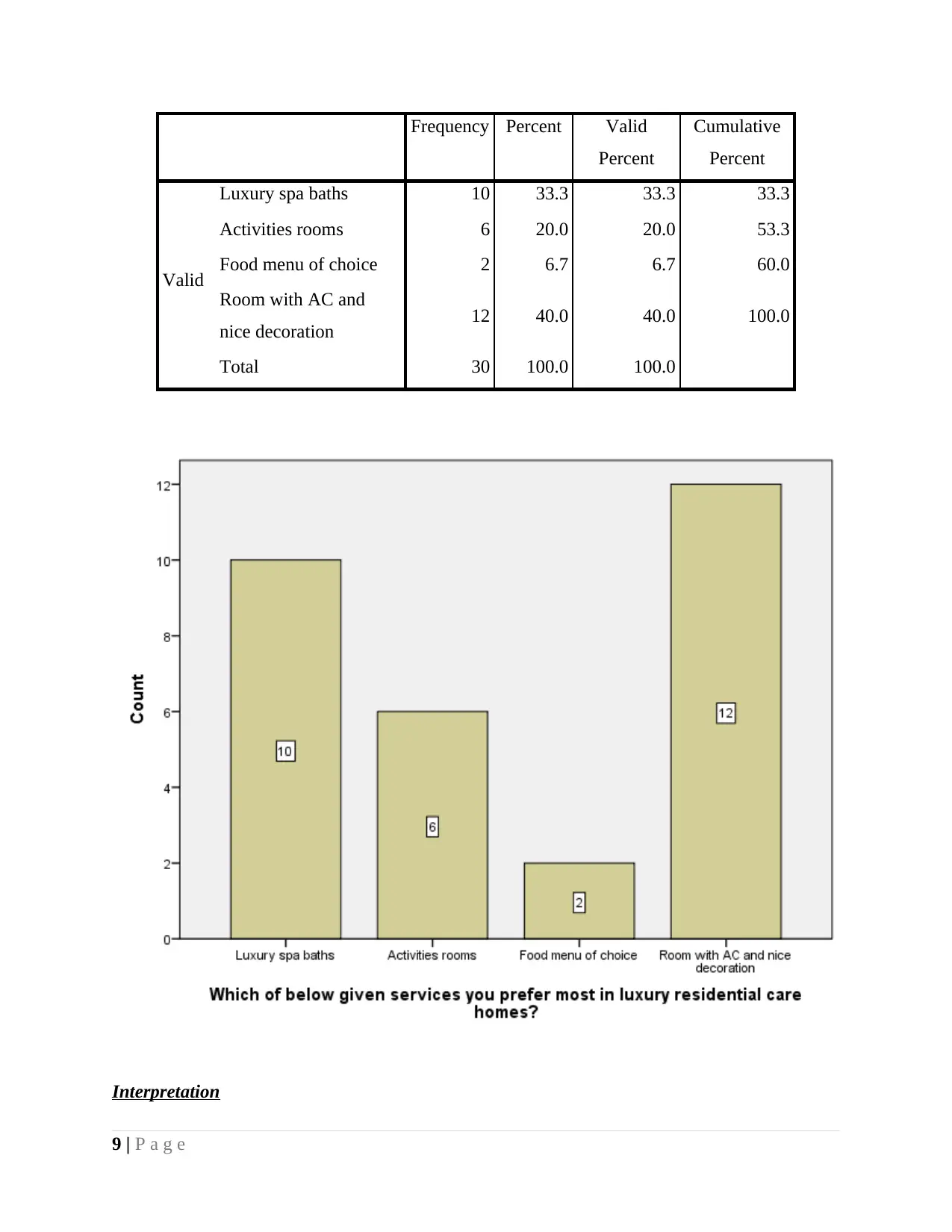
Frequency Percent Valid
Percent
Cumulative
Percent
Valid
Luxury spa baths 10 33.3 33.3 33.3
Activities rooms 6 20.0 20.0 53.3
Food menu of choice 2 6.7 6.7 60.0
Room with AC and
nice decoration 12 40.0 40.0 100.0
Total 30 100.0 100.0
Interpretation
9 | P a g e
Percent
Cumulative
Percent
Valid
Luxury spa baths 10 33.3 33.3 33.3
Activities rooms 6 20.0 20.0 53.3
Food menu of choice 2 6.7 6.7 60.0
Room with AC and
nice decoration 12 40.0 40.0 100.0
Total 30 100.0 100.0
Interpretation
9 | P a g e
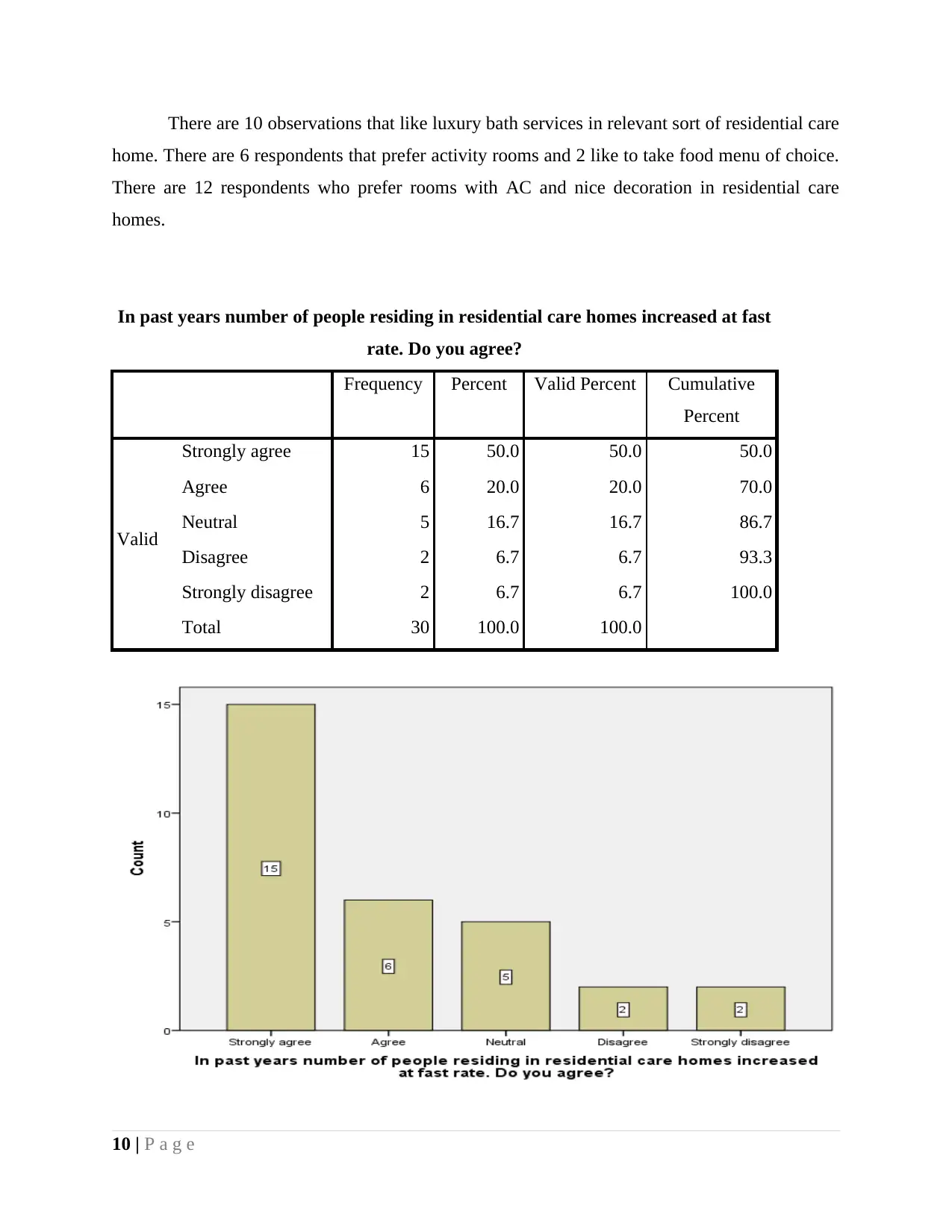
There are 10 observations that like luxury bath services in relevant sort of residential care
home. There are 6 respondents that prefer activity rooms and 2 like to take food menu of choice.
There are 12 respondents who prefer rooms with AC and nice decoration in residential care
homes.
In past years number of people residing in residential care homes increased at fast
rate. Do you agree?
Frequency Percent Valid Percent Cumulative
Percent
Valid
Strongly agree 15 50.0 50.0 50.0
Agree 6 20.0 20.0 70.0
Neutral 5 16.7 16.7 86.7
Disagree 2 6.7 6.7 93.3
Strongly disagree 2 6.7 6.7 100.0
Total 30 100.0 100.0
10 | P a g e
home. There are 6 respondents that prefer activity rooms and 2 like to take food menu of choice.
There are 12 respondents who prefer rooms with AC and nice decoration in residential care
homes.
In past years number of people residing in residential care homes increased at fast
rate. Do you agree?
Frequency Percent Valid Percent Cumulative
Percent
Valid
Strongly agree 15 50.0 50.0 50.0
Agree 6 20.0 20.0 70.0
Neutral 5 16.7 16.7 86.7
Disagree 2 6.7 6.7 93.3
Strongly disagree 2 6.7 6.7 100.0
Total 30 100.0 100.0
10 | P a g e
⊘ This is a preview!⊘
Do you want full access?
Subscribe today to unlock all pages.

Trusted by 1+ million students worldwide
1 out of 26
Related Documents
Your All-in-One AI-Powered Toolkit for Academic Success.
+13062052269
info@desklib.com
Available 24*7 on WhatsApp / Email
![[object Object]](/_next/static/media/star-bottom.7253800d.svg)
Unlock your academic potential
Copyright © 2020–2025 A2Z Services. All Rights Reserved. Developed and managed by ZUCOL.





